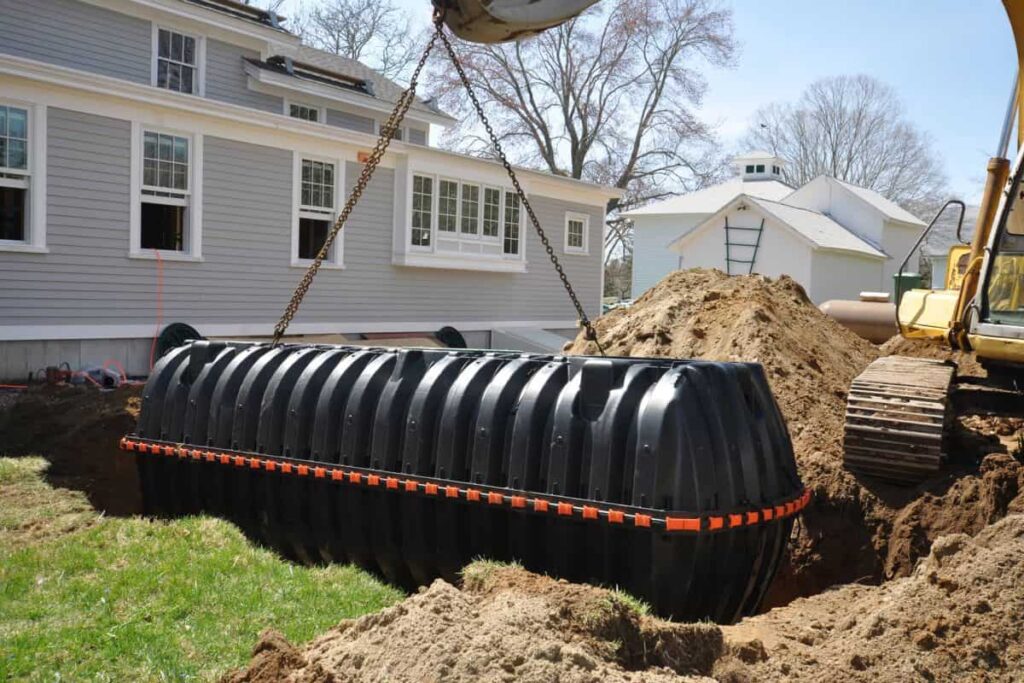A septic tank Installation is for wastewater treatment used commonly in rural and suburban areas without access to a centralized sewage system. It is a buried, watertight tank made of concrete, fibreglass, or plastic designed to collect. And treat household wastewater from toilets, sinks, showers, and other plumbing fixtures.
Solid waste settles to the bottom and forms sludge inside the septic tank, while lighter particles float to the top and form scum. The liquid effluent in the middle layer flows out of the septic tank and goes to a drain field, where it is further treated by the soil. In case of any defects and emergencies related to septic tanks or drainage system CCTV Drain Survey in Guildford helps a lot in solving them. But make sure to contact a reputable company, as dealing with septic tanks and drainage systems can sometimes be an arduous task to deal with.
Septic tanks require regular maintenance. Such as pumping out the accumulated sludge and scum, to prevent blockages and ensure proper functioning. They are subject to local regulations and may require permits and inspections. Proper use and maintenance of septic tanks are essential to prevent groundwater contamination and protect public health and the environment.
Health And Environmental Impacts
When not properly managed, Septic tanks can have health and environmental impacts. Here are some potential implications:
Groundwater Contamination
If a septic tank is not functioning correctly, untreated sewage may leak into the surrounding soil and contaminate groundwater, a drinking water source for many households. Contaminated groundwater can pose health risks, as it may contain harmful pathogens and pollutants.
Surface Water Pollution
Septic tank effluent that overflows or leaks from the tank can find its way into nearby surface water bodies like lakes, streams and rivers. This can cause water pollution, leading to the degradation of aquatic ecosystems and harm to wildlife.
Public Health Risks
Improperly functioning septic tanks can release untreated sewage into the environment, which may contain harmful bacteria, viruses, and other pathogens. This can pose health risks to humans, especially if it gets mixed with contaminated water or consumed contaminated food grown in the vicinity of the septic tank.
Odor and Nuisance
If a septic tank is not adequately maintained. It can produce unpleasant odours and attract insects and pests, creating a nuisance for the surrounding area.

Costly Repairs
Neglecting septic tank maintenance can lead to costly repairs and replacements. Pumping out accumulated sludge and scum, inspecting. And repairing tank components, and maintaining drain fields are essential to ensure the proper functioning and prevent costly issues.
Following local regulations and guidelines for septic tank installation, use, and maintenance is essential to minimize health and environmental impacts. Regular inspection, proper use of water, appropriate disposal of household waste. And timely maintenance are vital in preventing adverse effects from septic tanks on human health and the environment.
Soil’s Impact On Septic Tanks
The soil plays a critical role in the functioning of septic tanks. Here are some key impacts of soil on septic tanks:
Drainage and Absorption
The soil in the drain field area of a septic system is responsible for absorbing and filtering the liquid effluent from the septic tank. The soil type and quality can significantly affect the rate of absorption and drainage. Soil with reasonable percolation rates, such as sandy or loamy soil, allows efficient effluent absorption into the ground, preventing saturation and potential backups. On the other hand, soil with poor percolation rates. Such as clay or compacted soil, can lead to drainage issues and cause the effluent to pool on the surface or back up into the septic tank.
Treatment of Effluent
The soil also acts as a natural filter and removes harmful bacteria and other pollutants from the septic tank effluent as it percolates through the soil layers. The composition and quality of soil, such as its texture, structure, and organic content, influence the ability of the soil to treat the effluent and protect groundwater from contamination.
Soil Erosion and Slope Stability
Proper grading and soil erosion control around the septic tank. And drain field area are crucial to prevent soil erosion and maintain slope stability. Soil erosion can lead to sedimentation in the drain field, clogging the soil pores and reducing the system’s effectiveness.
Compaction and Soil Disturbance
Construction activities, heavy vehicle traffic, and other disturbances on the soil above or around the septic tank and drain field area can cause soil compaction, reducing the percolation rates and affecting the system’s performance. It is important to avoid soil compaction and disturbance in these areas to maintain proper drainage and treatment of the septic tank effluent.
Soil Chemistry and Nutrient Cycling
The chemistry and nutrient cycling of the soil can also impact the performance of septic tanks. Soil pH, nutrient levels, and microbial activity in the soil can affect the breakdown of organic matter in the septic tank effluent and the overall treatment process.
Must Read: Most Useful Methods of Roofing That Keeps You Cool in Summer

